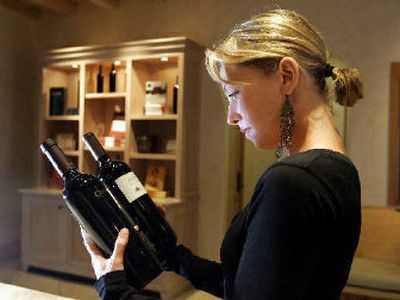Message on a bottle

NAPA, Calif. — Next time your favorite leading man pours a pinot or syrah, take note. You may be looking at a product placement.
Whether it’s as a background set decoration or a starring role in a white tablecloth dinner, winemakers are increasingly finding ways to send viewers an advertising message on a bottle.
“Product placement is here and it’s here to stay,” says Jenny Turnbull, a Los Angeles agent who has made getting screen time for California wines a key part of her business.
Wine has paired with movies for decades — James Bond baffled a villain or two with his vintage know-how. But the connection between Hollywood and wine has picked up in recent years as more vintners seek to get their brands in the picture.
Unlike some other industries, wineries don’t generally pay for product placement. Instead, they try to get attention by donating cases of their wine to show biz events and celebrity parties and hiring agents like Turnbull who look for opportunities by reading scripts and keeping in touch with studios.
Picking the right wine for a scene requires close attention, says Turnbull, who spent 10 years with Fox, most recently doing product placement for 20th Century Fox, before founding her own business, The Placement Agency.
So, when a prop master called asking for wine for a family dinner scene in HBO’s Six Feet Under, she sent over a case of cabernet sauvignon from Turnbull Wine Cellars, a Napa Valley wine she admires as an “elegant, special occasion kind of wine.”
“We don’t say, `You want a red wine? Here’s a red wine,”’ says Turnbull, no relation to the winery. “We try to make it really appropriate for the setting.”
There are no guarantees. Weeks of negotiations can go for naught if a scene gets cut. On the other hand, a bottle intended to be in the background of a scene can shoot to “hero placement,” if it ends up in an actor’s hands.
Even when all goes well, it may be hard to identify wine bottles since they don’t have the iconic recognition of, say, a Coca-Cola can.
Still, proponents say the exposure is worth the effort.
At the Clos du Val winery in Napa Valley, officials have been pursuing product placement for about five years and calculate appearances of their wines on TV and movie sets have yielded thousands of dollars worth of publicity, said Holly Myers, vice president of marketing.
Like other wineries, Clos du Val doesn’t pay for play, but has donated wine for a number of show biz bashes and works with a marketing agency, Set Resources.
A successful placing was in the movie “The Terminal,” in which Tom Hanks orders a Clos du Val cabernet sauvignon for a romantic dinner.
“It’s not something where we’re on a major TV show Thursday night and Friday morning our phones are ringing off the hook,” Myers said. “For us, it’s there as a process, getting your wine into the hands of the right people. Word will kind of spread.”
Interestingly, the big story recently on wine and movies wasn’t a classic case of product placement. The 2004 grape caper movie “Sideways,” is credited with boosting sales nationwide of the pinot noir beloved by main character Miles. But in that case, the filmmakers sought out products and places they liked rather than being pitched.